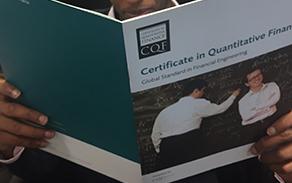In Conversation with CQF Alumni: Werner Trabesinger

Werner Trabesinger, Head of Quant Products, Pexapark
Werner earned the CQF in 2016. He started his career as a Risk and Model Auditor and has since become Head of Quant Products at Pexapark. We spoke to Werner about quant career opportunities in energy trading and the skills needed for the future.
How did you decide to pursue a career in quant finance and how did that path unfold?
I studied Physics to PhD level at ETH Zurich. After some reflection, I decided not to pursue an academic career, so I looked for a place to put my mathematical skills to work, which led me to banking. My first job was to audit models in a mid-sized Swiss bank. I worked there for about two years and then took a job with UBS Investment Bank in Zurich, focusing on risk management for fixed income, FX, and equities. This was a good role to get started in a trading environment, but I really wanted to be in trading. My manager at UBS moved to a power trading firm, and I soon joined him, initially trading relatively vanilla structured deals. After about a year, I took the lead of the Structured Trading desk, working in proprietary trading of electricity, gas, coal, carbon, as well as a lot of deal structuring. A general feature of commodity trading is that structured trades can be rather complex and tailored to meet specific customer needs. Work at the desk was very varied, as we would discuss deals with customers, structure them, price them, negotiate and finally execute, hedge, and manage residual risks.
How did you get to your current role and what does it involve?
After almost ten years running the Structured Trading desk, two of my colleagues moved on to found Pexapark and were looking for someone to set up a team of quants there. The firm’s initial software product was a benchmarking platform for renewable energy deals to help the fledgling European merchant (i.e., non-subsidized) market for renewable energy with deal pricing. As many firms in the sector lacked quant skill, we had the perfect product at the right time to support them and the product became a de facto benchmark in the industry. Contrary to what quant colleagues in classic finance may think, renewable energy modeling is an exciting field to be in. Not only are there pricing dynamics at many different timescales down to 15-minute intervals, but transacted volumes are stochastic, as there is high production at certain times and no production at other times, driven by sun and wind.
You are an alum of the Certificate in Quantitative Finance (CQF). When and why did you enroll on the program?
Over the years in banking, I had gained some expertise in models and methods, but I felt that I should thoroughly learn the theoretical underpinnings of quant finance, so I enrolled for the 2016 cohort of CQF. With deal structuring at the core of running a Structured Trading desk, I frequently had to build non-standard models within a short time. Also, when internally defending and obtaining approval for my models, I had to deal with seasoned risk and valuation quants. The CQF equipped me with all necessary skills to do this confidently. I find that the curriculum strikes a very good balance between theory and practice and is focused on hands-on work in the homework assignments. This spirit of implementation is particularly key in renewable energy, where incomplete data sets and incomplete markets are the norm rather than the exception. I see the same thinking leads some of my team members to enroll in CQF – typically after some learning on the job, they want to complete their grasp of theory – the benefits for day-to-day work usually materialize even while they are taking the program.
From an employment perspective, are there a lot of opportunities in the energy trading space?
There is great opportunity for quants, but few are aware of that. This is because firms in the space are often infrastructure investment funds. They tend to be project finance people, exclusively focused on the investment case, and modeling usually means building spreadsheet investment models. What they often do not understand well, are the market price dynamics and financial risks in energy and that's exactly where Pexapark brings value because we quantify prices and risks for them. If you think of conventional energy trading, i.e., oil, electricity, or coal, there are highly standardized futures and forward products, relatively easy stuff. But when you look at renewable energy, where there's not only stochasticity of both price and volume, then everything becomes more complex. There is a microstructure because delivery occurs down to fifteen-minute time windows and that's where quants are in high demand. There are a lot of engineers in this space, who understand how PV panels or wind turbines work, but they're not usually well educated in quant modeling. On my team, I need people who can bridge the gap between the world of quant modeling and the particularities of renewable energy and create valuation and risk models for our customers.
In the future, are there likely to be more opportunities for people who may have more unique and complementary skillsets?
When hiring, I've always found it very useful to consider people with diverse backgrounds, who are equipped with a high level of intellectual curiosity. At Pexapark, we encourage people to do projects with us, for example, via internships early on in their academic path. This gives us pretty good visibility of their curiosity, their willingness to learn and to perform and also, we can bring them into the team gradually. Considering the team as it stands, we have a lot of physicists and people who have done MBAs with an econometric focus. We also have engineers and programmers, who have acquired quant skills over time. As for the working style, I like to expose my team members to customers directly because it forces them to consider things from a business standpoint. If they can bridge the gap between a commercial view and a modeling view and can explain, in layman's terms, what a model does, that's exactly what I am after. My team works across the organization, so my quants must interact with user interface designers as well as programmers that support the backbone behind all our software. This is what keeps the work exciting; it is less academic and more applied. The pace of innovation is frantic: starting with price benchmarks and operational solutions four years ago, we are now also serving customers looking to build batteries or electrolyzers and will certainly see an increasing demand for AI/ML solutions soon. In this sense, being a quant in the renewables space is certainly future-proof.
Find out more about the CQF program
To discover how the CQF program could help you go further in your career, download a brochure or register to join an information session.




